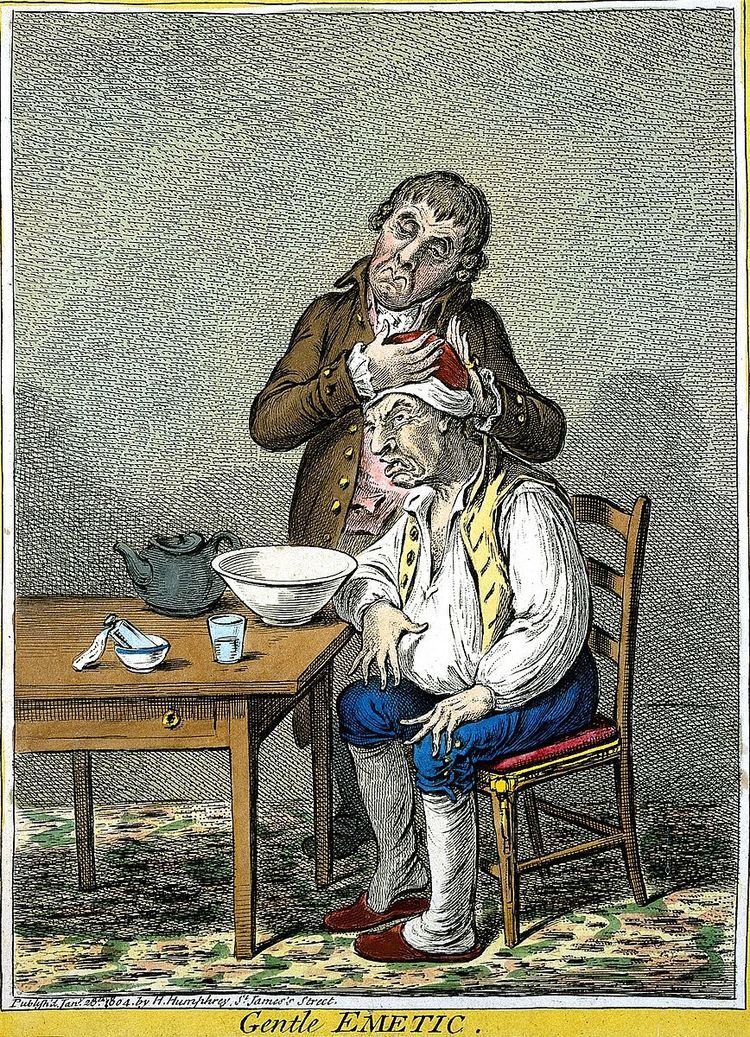 | ||
Heroic medicine, also referred to as heroic depletion theory, was the therapeutic method advocating for rigorous treatment of bloodletting, purging, and sweating to shock the body back to health after an illness caused by a humoral imbalance. Rising to the front of orthodox medical practice in the "Age of Heroic Medicine" (1780-1850), it fell out of favor in the mid 19th century as more gentle, palliative treatments became the norm.
Contents
Practices
Heroic medicine does not have a definitive start date, as its treatments themselves were not new to the field of medicine. Bloodletting, purging, and sweating are cemented firmly in medical tradition back to the advent of humoral theory in the time of Hippocrates and Galen. With hopes of rebalancing the body’s delicate homeostasis of four humors--blood, phlegm, black bile, and yellow bile—the careful manipulation of bodily discharge, like bleeding and evacuation, was believed to nudge the body back to its healthy, natural state. The physician’s role was always to monitor the path of the body’s humoral levels back to normal.
Heroic medicine takes this methodology to the extreme, draining significant volumes of blood and ordering intensive regimens of evacuation. It was not uncommon for physicians to strive to drain up to eighty percent of a patient's blood volume. Likewise, dramatic evacuations, both by pharmacological emetics and laxatives, induced the forceful removal of bodily fluid. Commonly used emetics include senna and tartar emetic. General intestinal cleansing was instigated from massive doses of calomel, to the point of acute mercury poisoning. Sweating was also induced using blisters of cantharidin and diaphoretic.
In contrast to more personalized medicine of the past, heroic medicine includes a much more generalized, “one-size-fits-all” approach to humoral theory. A standard, rigorous course of treatment was prescribed for all patients, from young children to the elderly.
History
Pockets of medical methodology that can be classified as “heroic” appear in the early 17th century with Parisian physician Guy Patin and French anatomist Jean Riolan the Younger. Patin, nicknamed “the Grand Saigneur” or the Grand Bloodletter, was infamous for his rigorous procedure plans, which included incredibly intensive courses of bloodletting and senna. Because heroic medicine used popular techniques, it is difficult to absolutely classify a healer’s therapeutic epistemology as heroic. Intensive bloodletting treatments can be identified throughout American history, with William Douglass in Massachusetts advocating for a heroic treatment plan in the early 18th century. While there were practitioners here and there who were particularly eager to perform aggressive treatment, heroic medicine did not become a concentrated school of thought until later in the 18th century.
Many associate Benjamin Rush with an abrupt acceptance of heroic techniques into the realm of mainstream medicine, especially in America. Founding father, creator of University of Pennsylvania’s medical school, and known as the "American Hippocrates," Rush was well respected and revered in the medical field. The Philadelphia Yellow Fever outbreak in 1793 is looked upon as a major event in the merging of heroic medicine into the course of best practices in the medical profession. Much of the city was left incapacitated by the rampant epidemic. As healers fled the city, Rush bravely remained to treat people, and ultimately himself, with his drastic regimens consisting of intensive bloodlettings and purgatives. While Rush was reluctant to claim heroic medicine as his creation, he became the figurehead for the school of thought. He taught many students who then carried the tradition to other parts of the United States. Varied in its influence, heroic medicine was particularly concentrated around Pennsylvania and spread into other locations. The term “heroic medicine” was coined later in the mid 19th century to describe extreme treatment.
Heroic medicine was used to treat George Washington on his deathbed in 1799. He was drained of four quarts of blood and given several blisters of cantharidin to induce sweating. Despite the best efforts of a team of physicians trying to apply the best, most cutting-edge medical methodology, Washington died shortly after the rigorous heroic treatment.
Fall of Heroic Medicine
Heroic medicine became less favored with the rise of more conservative, viable options in the medical marketplace like hydrotherapy and homeopathy. Even during its heyday, heroic medicine faced criticism from physicians and alternative medicine healers who pushed for more natural cures.
While is easy to discuss and question the ethical implications of such a severe course of treatment, it is important to remember that in the time period physicians were operating under their best understanding of the body and its physiology. This standard of care was considered to be the most modern and successful cure, as evidenced in the fame bestowed upon Rush after the Yellow Fever epidemic.
